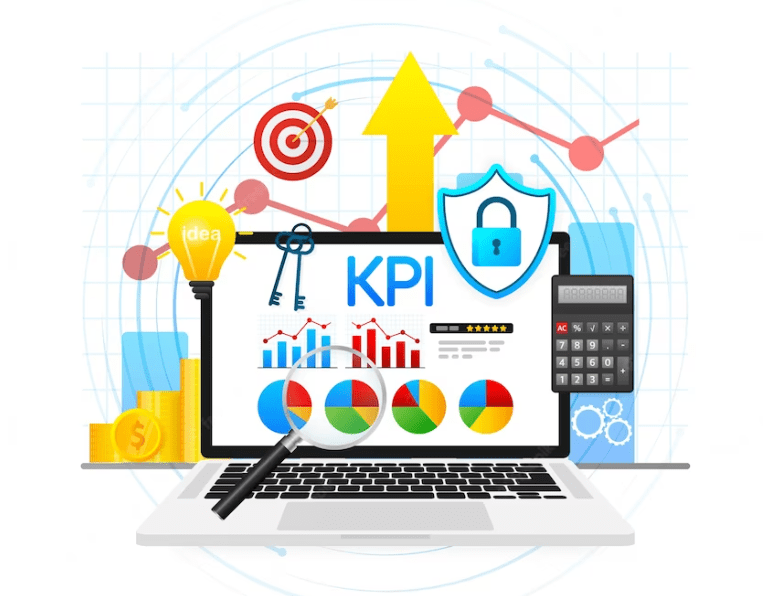Running an ecommerce business isn’t just about selling products online. It’s about understanding your customers and making data-driven decisions that lead to growth. To do this effectively, you need to monitor certain key performance indicators for ecommerce. These KPIs can provide you with crucial insights into how well your business is doing and where improvements can be made.
Imagine you’re driving a car without a dashboard – you won’t know your speed, fuel level, or engine health. Similarly, without tracking KPIs, you’re running your business blind. You won’t know if your marketing efforts are paying off, if you’re maximizing your sales, or if your customers are truly satisfied.
That’s why you should keep an eye on a few vital KPIs, such as conversion rate, average order value, customer acquisition cost, customer lifetime value, and profitability and growth potential. These will not only help you measure your success but also guide your future strategies.
Conversion Rate: Measure of Sales Effectiveness
Wondering how effectively your online store is making sales? Let’s take a look at your conversion rate. It will give us the real scoop!
Your conversion rate is the percentage of visitors to your website who complete a desired action, like buying a product. It’s a crucial metric to measure the success of your eCommerce business. It’s not just about how many people visit your site but how many of those visitors actually make a purchase.
Now, you might be thinking, ‘Why is the conversion rate so important?’ Well, it’s simple. A high conversion rate means your website is well-designed, compelling, and easy for customers to use. It means you’re offering products or services that meet the needs of your customers. And it means you’re effectively using your marketing dollars to attract the right audience.
But there’s more! Research shows that improving your conversion rate can significantly increase your revenue without spending more on advertising.
So, how do you improve your conversion rate? Start by understanding your customers. Use analytics to gather data about their behavior, preferences, and needs. Then, optimize your website design, product offerings, and marketing strategies based on this data.
Remember, even a small increase in your conversion rate can have a big impact on your bottom line. So don’t underestimate the power of this key performance indicator.
It’s time to make your website work harder for you!
Average Order Value: Maximizing Revenue per Transaction
Don’t you just love it when each purchase on your site brings in more revenue? Maximizing your Average Order Value (AOV) can make that thrilling feeling a daily reality!
AOV is a key performance indicator that measures the average total of every order placed over a certain period. This means if you can increase your AOV, you’re essentially squeezing more value out of every transaction, leading to a significant impact on your overall revenue. Doesn’t that sound like a strategy worth investing in?
It’s not just about pushing for larger orders, though. You need to provide real value to your customers, and that means understanding what they want.
Research shows that customers are more likely to spend more if they perceive they’re getting a good deal. Bundle deals, discounts on minimum purchase thresholds, and loyalty programs can all incentivize customers to add that extra item to their cart. And don’t forget the power of upselling and cross-selling!
By recommending related or premium products, you can effectively increase your AOV. The key here is to show customers how these additional purchases will benefit them.
Raising your AOV isn’t just a short-term revenue boost, it can also help you grow your business sustainably. When done right, it can lead to higher customer satisfaction as customers feel they’re getting more value for their money.
Plus, it can help you stay competitive by allowing you to invest more in customer acquisition while maintaining profitability. So, start focusing on your AOV today and see how it can transform your ecommerce business. You’ll be amazed at the difference it can make!
Customer Acquisition Cost: Evaluating Marketing Efficiency
It’s crucial to keep a keen eye on your Customer Acquisition Cost (CAC) if you’re looking to evaluate the efficiency of your marketing efforts. CAC is the cost associated with convincing a potential customer to buy a product or service from your ecommerce platform.
This includes the cost of all marketing and sales efforts. By monitoring this crucial KPI, you can understand how much you’re spending to gain new customers, and whether your marketing strategies are cost-effective or need fine-tuning.
Evaluating CAC gives you insight into the financial health and sustainability of your business. If your CAC is high, it means you’re spending a significant amount of money to acquire a new customer. This isn’t necessarily a bad thing, especially if those customers are high-value and generate significant profit.
However, if your CAC is high and your customers aren’t generating enough revenue to offset the acquisition cost, you have a problem. To ensure your business stays profitable, your CAC should be proportionate to the lifetime value (LTV) of your customers.
Let’s consider a scenario where you’re spending more to acquire customers than they’re worth. This is a red flag, signaling that your marketing efforts are not efficient or your pricing strategy needs a review. But don’t be discouraged. Use this information to make informed decisions. Reevaluate your marketing campaigns, perhaps targeting more profitable customer segments or improving your product’s value proposition.
Remember, CAC is an actionable KPI that can guide you toward more profitable operations. So, keep an eye on it, understand it, and use it to drive your ecommerce success.
Customer Lifetime Value: Assessing Long-Term Customer Worth
You’ve got to keep in mind the concept of Customer Lifetime Value (LTV), as it’s a crucial metric for assessing the long-term worth of your customers.
LTV goes beyond the initial transaction, it calculates the total revenue you can expect from a customer throughout the entire duration of their relationship with your business.
If you’re not paying attention to this KPI, you could be pouring resources into acquiring customers who aren’t delivering a strong return on investment in the long run.
By measuring LTV, you can determine which customers are the most valuable and tailor your marketing and retention strategies accordingly.
Consider this: acquiring a new customer can cost five times more than retaining an existing one.
Plus, a loyal customer who makes regular purchases over several years is far more profitable than a one-time buyer.
So, focusing on boosting LTV can significantly drive up profitability.
Identifying high-LTV customers is just one part of the equation.
You also need to understand what drives their loyalty and repeat purchases.
Is it your product quality? Stellar customer service? Or perhaps your compelling loyalty program?
Once you’ve figured this out, you’re well on your way to fostering relationships with these valuable customers and increasing your ecommerce success.
Profitability and Growth Potential: Monitoring Business Success
Keeping a close eye on your business’s profitability and growth potential isn’t just a good idea—it’s essential for gauging your success.
In the competitive world of ecommerce, your ability to turn a profit and expand your market reach can make or break your enterprise. By tracking key performance indicators (KPIs) like gross profit margin, net profit margin, and year-over-year growth, you can better understand where your business stands and where it’s headed.
Research shows that businesses that regularly monitor and react to these KPIs are more likely to succeed in the long run. For example, keeping track of your gross profit margin—the difference between sales and cost of goods sold—can reveal how efficiently your business is operating. Similarly, your net profit margin, which subtracts operating expenses from gross profit, provides a clear picture of your business’s overall financial health. Monitoring your year-over-year growth allows you to understand your business’s expansion pace and if it’s in line with your goals.
Don’t underestimate the power of these KPIs. A positive gross profit margin signals that your business is effectively managing its costs, while a healthy net profit margin indicates that your operations are financially sound. And seeing steady year-over-year growth? That’s proof positive that your business is moving in the right direction.
So, make these KPIs a fundamental part of your ecommerce business strategy—you won’t regret it.
Frequently Asked Questions
How can I improve the overall user experience on my ecommerce platform?
Boost your ecommerce platform’s user experience by incorporating intuitive navigation, speedy page loads, and personalized shopping suggestions. Invest in mobile optimization and AI chatbots. Regularly test and refine your site’s user interface and experience.
What are some best practices for managing inventory in an ecommerce business?
Regularly review and adjust inventory based on sales data. Use an inventory management system for real-time tracking. Minimize overstocking to reduce costs. Prioritize high-selling items and consider drop shipping for low-selling ones.
How crucial is mobile optimization for ecommerce businesses?
Mobile optimization is absolutely vital for your ecommerce business. With most users now shopping on mobile, ensuring a seamless, user-friendly mobile experience can significantly drive sales and improve customer satisfaction.
What is the role of customer reviews and ratings in the success of an ecommerce platform?
Customer reviews and ratings significantly drive your ecommerce success. They build trust, influence purchasing decisions, and improve product visibility. Evidence shows that a single positive review can increase conversions by up to 10%.
How can social media marketing strategies boost my ecommerce sales?
Leveraging social media marketing can significantly boost your ecommerce sales. It helps in increasing brand awareness, attracting potential customers, and cultivating loyalty. Promote your products effectively and engage with your audience for optimal results.
Conclusion
You’ve got the power to drive your ecommerce business to new heights. By focusing on key performance indicators for ecommerce like conversion rate, average order value, customer acquisition cost, and customer lifetime value, you’re not just tracking numbers; you’re unlocking your business’s true potential.
Don’t overlook the importance of monitoring profitability and growth potential too. It’s not just about the here and now but building a sustainable, successful future.
Harness these KPIs and watch your ecommerce business flourish.


